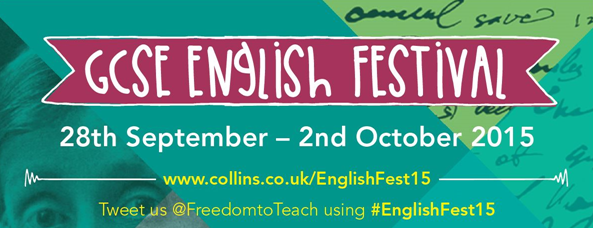Find out more about Collins GCSE English Festival here.
As you read this, you will be well into the new term, summer a place you stopped at only for a moment, like ‘Adlestrop’ and hopefully remembered equally fondly. But now the business of the new school year has begun and with it the demands of new GCSE specifications in English Language and English Literature. One of the key challenges in enabling students to progress is that traditionally Key Stages 3 and 4 often existed as separate silos, the one cut off from the other, yet it has long been established that schools which master the transition between the two tend to achieve better results, and mitigate the problems which sometimes arise when a student beginning his or her GCSE course suddenly faces more sharply-focused reading tasks, or has to write in sustained, developed ways, synthesising a range of skills.
So, what can be done in Year 9 to ease students into the new demands they will face? The Collins GCSE Core book includes a suggested scheme of work for the year which highlights three different phases over the school year. The Teacher’s Guide spells out a range of ideas, but I want to deal with elaborating on one from the first term in the scheme – ‘Building skills and sharing stories’
This focuses on instilling some good habits which can be taken across the year and into KS4, and the scheme suggests studying 2-3 short stories which suit your cohort.
My approach to this would be two-fold.
Firstly, try to get students to apply the same analytical framework across all three texts. This is a bit like ‘muscle-memory’ in sport – the repeated practice of an approach which eventually becomes second-nature and gives you Federer-like (or should that be Djokovic-like?) fluency. This analytical framework can be as simple as a grid which enables students to draw out the core ingredients of the short story – its structure and conventions (the story’s arc, sequence, focus of paragraphs, use of time/chronology) its language (distinctive vocabulary, types and variety of sentence, literary features/effects etc) and its voice (viewpoint, tone, formality – if relevant, perspective, tense etc). For engagement purposes, you can add a fourth category – reader response, if you like – what does it elicit in you, the reader, and how is it done? (see the other categories).
Of course, this isn’t the whole picture, but in term one of Year 9, establishing a variety of lenses (a phrase popular with awarding bodies) through which the story can be read and explored is key.
I think the second key element is to use the same stories as ‘reverse springboards’ – think of it as rather like a reversed video of someone diving into a pool – the completed dive is the story, but can we rewind back to how it began, what the stimulus was?
For example, ask students to suggest images, pictures, quotes or headlines that might have inspired the story they have read. You could provide a smorgasbord of possibilities, some literal, others more abstract and allow pairs or groups to sift through them, selecting possible sources of inspiration, trying to second guess the original writer’s working mind, seeing the text from inside out. No one is suggesting these were the actual images used by the writers of the stories (if they used images at all!) but the process of doing this should engender a key skill they will need to develop – creating narratives from images or simple statements (as required by the exam).
Then, using the same images they have selected, ask students to mindmap or otherwise generate new, alternative ideas for stories. At this point, you could reintroduce a blank version of the analytical framework, and get them – almost randomly – to make choices about tone, voice etc, decide on perspective – and then jot down the story arc they have come up with. They are, in this way, recreating the narrative – or, to continue the metaphor from earlier, styling a new ‘dive’ but through a model they have just explored. Encourage them to be bold – tell a story in the present, use the third person rather than the first, tell the story from an unusual angle, from a bystander, or an attendant lord…..etc.
Final stories might be measured up against the stories read earlier – are there echoes of the originals, or did the images spark entirely new creations?
The truth is, of course, that reading and writing cannot be separated. The one feeds the other, but by developing the muscle-memory habits of taking an analytical eye to texts – and lots of them – and digging inside the creative process in order to feed their own imaginations – you will make the transition between stages that much smoother.
By Mike Gould.





